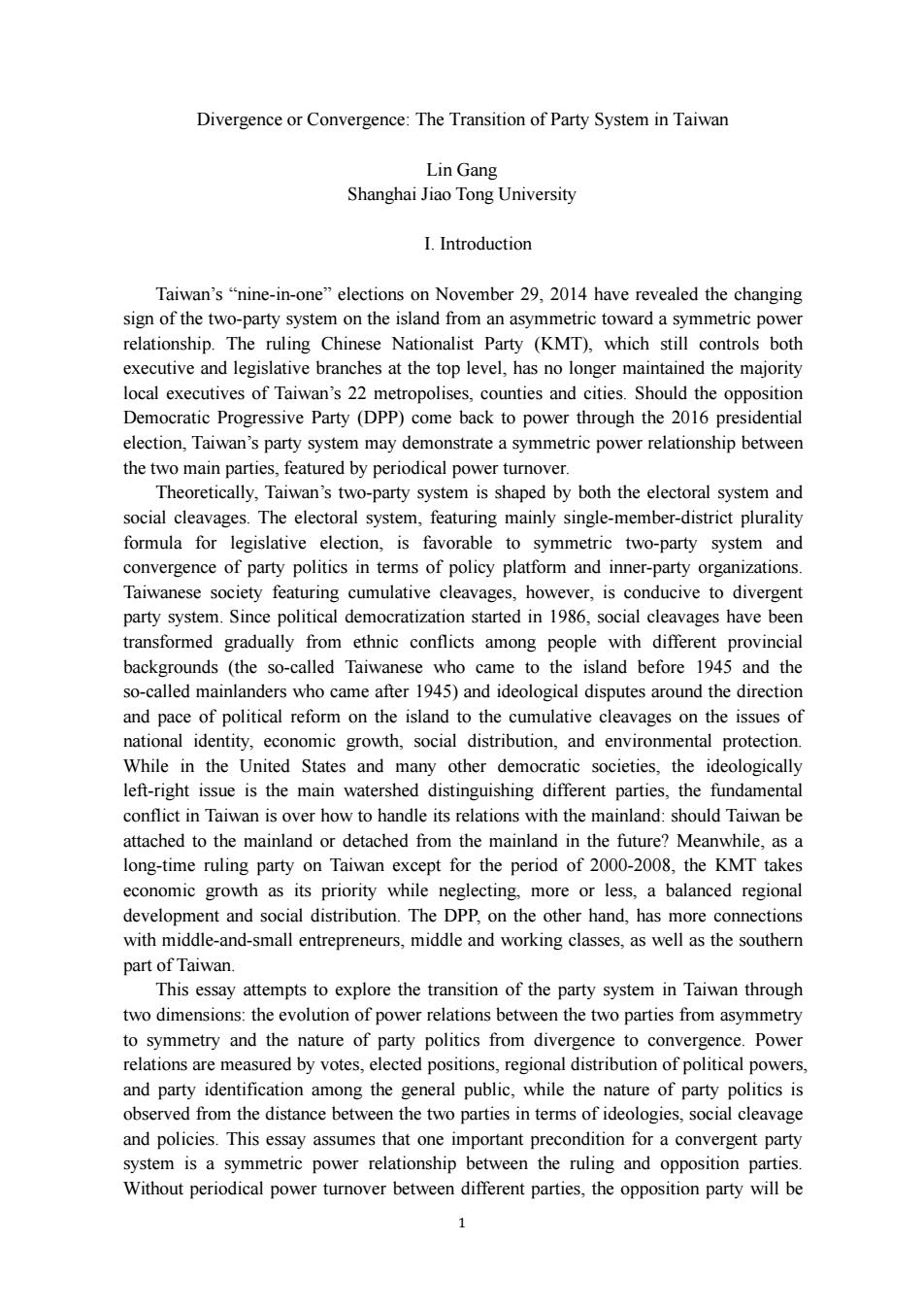正在加载图片...

Divergence or Convergence:The Transition of Party System in Taiwan Lin Gang Shanghai Jiao Tong University I.Introduction Taiwan's "nine-in-one"elections on November 29,2014 have revealed the changing sign of the two-party system on the island from an asymmetric toward a symmetric power relationship.The ruling Chinese Nationalist Party (KMT),which still controls both executive and legislative branches at the top level,has no longer maintained the majority local executives of Taiwan's 22 metropolises,counties and cities.Should the opposition Democratic Progressive Party (DPP)come back to power through the 2016 presidential election,Taiwan's party system may demonstrate a symmetric power relationship between the two main parties,featured by periodical power turnover. Theoretically,Taiwan's two-party system is shaped by both the electoral system and social cleavages.The electoral system,featuring mainly single-member-district plurality formula for legislative election,is favorable to symmetric two-party system and convergence of party politics in terms of policy platform and inner-party organizations. Taiwanese society featuring cumulative cleavages,however,is conducive to divergent party system.Since political democratization started in 1986,social cleavages have been transformed gradually from ethnic conflicts among people with different provincial backgrounds (the so-called Taiwanese who came to the island before 1945 and the so-called mainlanders who came after 1945)and ideological disputes around the direction and pace of political reform on the island to the cumulative cleavages on the issues of national identity,economic growth,social distribution,and environmental protection. While in the United States and many other democratic societies,the ideologically left-right issue is the main watershed distinguishing different parties,the fundamental conflict in Taiwan is over how to handle its relations with the mainland:should Taiwan be attached to the mainland or detached from the mainland in the future?Meanwhile,as a long-time ruling party on Taiwan except for the period of 2000-2008,the KMT takes economic growth as its priority while neglecting,more or less,a balanced regional development and social distribution.The DPP,on the other hand,has more connections with middle-and-small entrepreneurs,middle and working classes,as well as the southern part of Taiwan. This essay attempts to explore the transition of the party system in Taiwan through two dimensions:the evolution of power relations between the two parties from asymmetry to symmetry and the nature of party politics from divergence to convergence.Power relations are measured by votes,elected positions,regional distribution of political powers, and party identification among the general public,while the nature of party politics is observed from the distance between the two parties in terms of ideologies,social cleavage and policies.This essay assumes that one important precondition for a convergent party system is a symmetric power relationship between the ruling and opposition parties. Without periodical power turnover between different parties,the opposition party will be1 Divergence or Convergence: The Transition of Party System in Taiwan Lin Gang Shanghai Jiao Tong University I. Introduction Taiwan’s “nine-in-one” elections on November 29, 2014 have revealed the changing sign of the two-party system on the island from an asymmetric toward a symmetric power relationship. The ruling Chinese Nationalist Party (KMT), which still controls both executive and legislative branches at the top level, has no longer maintained the majority local executives of Taiwan’s 22 metropolises, counties and cities. Should the opposition Democratic Progressive Party (DPP) come back to power through the 2016 presidential election, Taiwan’s party system may demonstrate a symmetric power relationship between the two main parties, featured by periodical power turnover. Theoretically, Taiwan’s two-party system is shaped by both the electoral system and social cleavages. The electoral system, featuring mainly single-member-district plurality formula for legislative election, is favorable to symmetric two-party system and convergence of party politics in terms of policy platform and inner-party organizations. Taiwanese society featuring cumulative cleavages, however, is conducive to divergent party system. Since political democratization started in 1986, social cleavages have been transformed gradually from ethnic conflicts among people with different provincial backgrounds (the so-called Taiwanese who came to the island before 1945 and the so-called mainlanders who came after 1945) and ideological disputes around the direction and pace of political reform on the island to the cumulative cleavages on the issues of national identity, economic growth, social distribution, and environmental protection. While in the United States and many other democratic societies, the ideologically left-right issue is the main watershed distinguishing different parties, the fundamental conflict in Taiwan is over how to handle its relations with the mainland: should Taiwan be attached to the mainland or detached from the mainland in the future? Meanwhile, as a long-time ruling party on Taiwan except for the period of 2000-2008, the KMT takes economic growth as its priority while neglecting, more or less, a balanced regional development and social distribution. The DPP, on the other hand, has more connections with middle-and-small entrepreneurs, middle and working classes, as well as the southern part of Taiwan. This essay attempts to explore the transition of the party system in Taiwan through two dimensions: the evolution of power relations between the two parties from asymmetry to symmetry and the nature of party politics from divergence to convergence. Power relations are measured by votes, elected positions, regional distribution of political powers, and party identification among the general public, while the nature of party politics is observed from the distance between the two parties in terms of ideologies, social cleavage and policies. This essay assumes that one important precondition for a convergent party system is a symmetric power relationship between the ruling and opposition parties. Without periodical power turnover between different parties, the opposition party will be